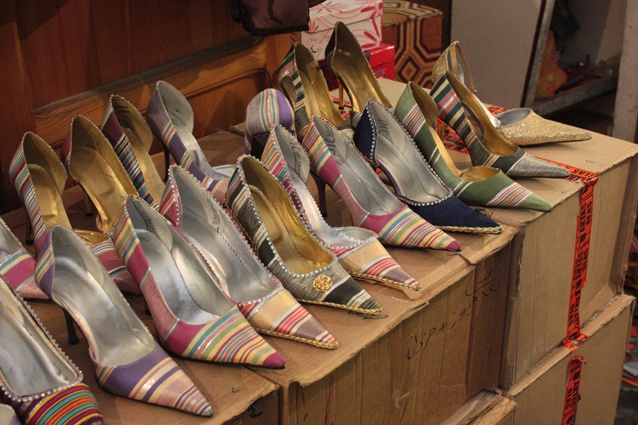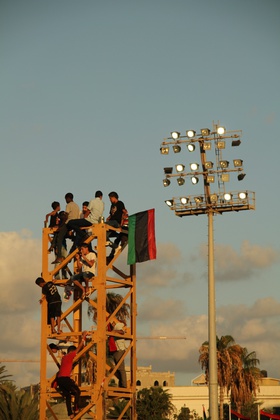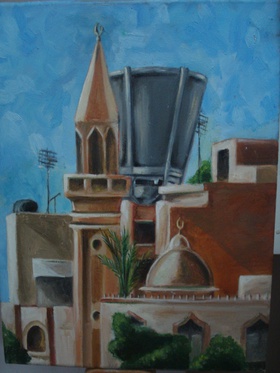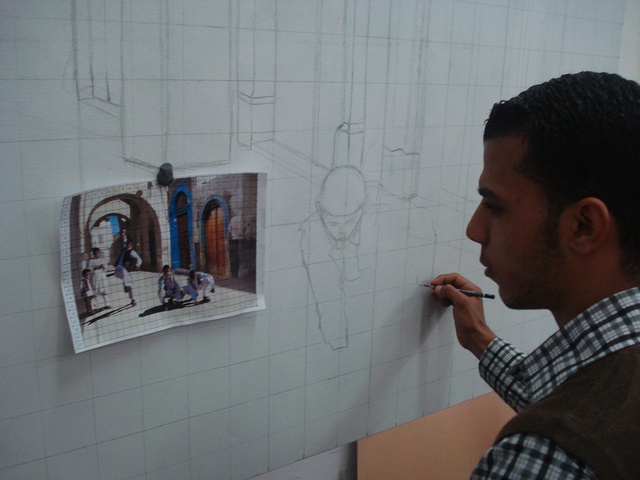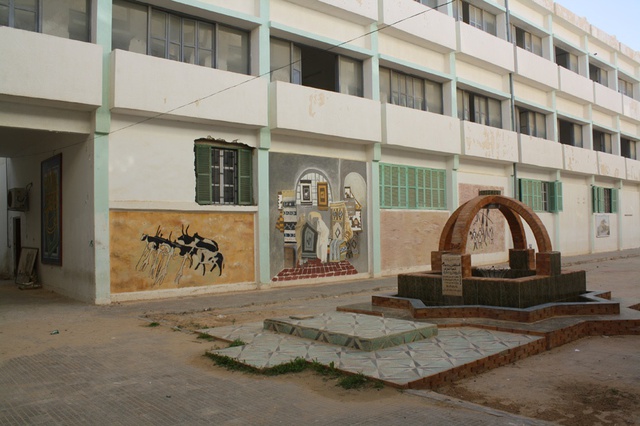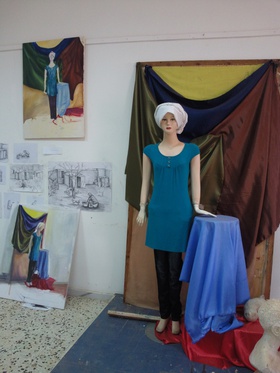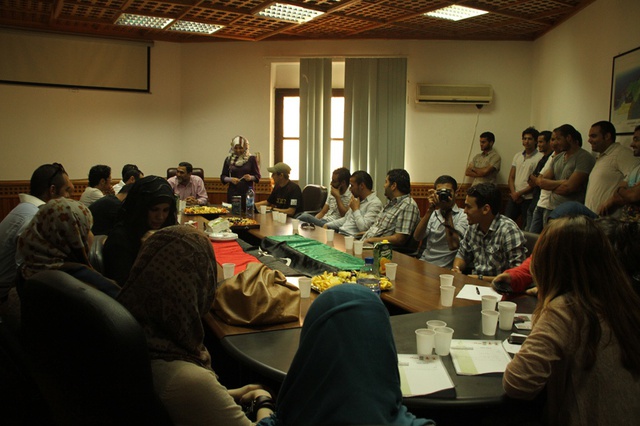Essays
Filling the Gaps
Arts Infrastructures and Institutions in Libya Post-Dictatorship
Historically, Libya has always been subject to consecutive, centralized invasions, from the ancient Greeks and Romans to Byzantines, Ottomans and, later, the Italians. During the Ottoman era, caliphs installed in Tripoli had to send armies to the east to force indigenous (Bedouin) rebellious populations refusing to pay taxes. The southern regions also had to be controlled, since they were the commercial entrance for European goods (gold, salt, leather, feathers, slaves and others) coming in from the west.
During the European colonial period that followed, Italy struggled to control the country, which they christened 'Italy's fourth shore', even though the population at that time was extremely poor and hardly reached 1 million inhabitants. In an area of desert measuring roughly 1,700,000 kilometres squared, with a coastal strip of land stretching 2000 kilometres, Italian colonialists, like their ancestors, built bridges, streets and train tracks (which disappeared during the Gaddafi period) to reach new territories and construct city nuclei on already existing settlements. The Italians believed that infrastructure was needed since there were huge swathes of land to cultivate, brand new city centers, and an entire population of indigenous people to serve them.
This period ended after World War II, when King Idris was nominated by the UN General Assembly to reign over an independent united country split into three: Fezzan (south) under French rule to add to Chadian, Nigerian and Algerian colonized territories, as well as Cyrenaica (east) and Tripolitania (north-west) which were British (American) protectorates. These divisions did not follow any ethnic or tribal pattern, even though Libya has been predominately shared by the following ethnic groups (if we may say so): the Arabs, the Berbers, the Tuareg, an indigenous population who are grouped under the term 'Amazigh', and the Toubou, the latter two being minorities. Rather, the allies simply shared the country depending on geopolitical needs, and recently, these 'colonial' subdivisions of the country have been dangerously reinstated due to the lack of security, corruption and a weak central government.
All these invasions have left their traces on the Libyan landscape, carving out various historical and cultural layers throughout the country, which are hinted at through a diversity of facial features, traditions and crafts. Other cultures were introduced during Gaddafi's early 'reign' in the 1970s and 80s – either through war orphans from Mauritania, who were raised in camps in the western valleys (some attacked the Nafusa Mountain villages during the revolution), or families from Chad (allied with Gaddafi) after the Ouzou War, who wereimplanted in camps around the city of Sebha during the 1980s, which eventually became pseudo-cities (entire villages designed with full amenities but, for some reason, ended up with only houses being built). These moves towards producing diversity (and division) were specifically used during Gaddafi's dictatorship so as to fragment the country, thus creating frictions between neighbouring cities (mostly used in the western and southern areas).
This emphasized difference, thus creating inequality and disparity for better control. Libyan nationality was revoked to many; mountain cities were deprived of natural water resources and had to buy tanks from the implanted cities downhill; most manager positions in the eastern cities were only given to westerners; advancement wasn't awarded on merit but depended on corruption and fidelity towards the revolutionary committee; cheating students surpassed studious ones in grades and later become directors. Just imagine Gotham city without Batman and Joker as 'president'.
Yet, in a spacious and diverse country like Libya, a decentralized system has always brought richness to cultural discourse, especially when thinking about the legacy of this extended patch of land. In a democratic environment, where justice and people's rights could be or are being implemented, the cultural variety ingrained in Libya's history could be seen as an inspirational well rather than a source of division and conflict. Besides the oil that has been the source of wealth for a minority of Libyans and mostly a plague for the rest, each city or area in Libya has cultural specificities – either natural, ethnic or historical – that could be developed for the greater good of the nation as a whole.
* * *
The current situation in the country when it comes to 'culture' may be seen as a natural result of the decades spent under Gaddafi's 'popular revolution', which began in 1973 on the day of the prophet Mohammed's birth (Gaddafi loved to and always used flashy dates). That day, Gaddafi's revolution announced the following intentions:
1. Stop and review all laws the country used during the exiled king's reign.
2. Persecute and eliminate all members of parties.
3. Announce the cultural revolution.
4. Install the administrative revolution and bureaucracy.
5. Announce the people's revolution and governance.
The elaboration of this list resulted in the publication of the Green Book in 1976, which combined a mix of Marxism, Socialism and other unique snippets of ideology, such as 'the difference between the man and the woman is that the women have periods and men don't', or 'no freedom to a society that eats from overseas', and many other guru-like proclamations. These were the statements upon which the creation of the revolutionary committees in 1979 were formed, a year that marked the start of Libya's toughest and darkest years. During this time, students (as a result of the 'student revolution' on 7 April 1976) were hanged in university parking lots and stadiums in the presence of their fellow students, who were packed in to assist and cheer as their peers swung their breath out for broadcast television spots aired during afternoon tea-time. All opposition, dubbed by the regime as 'stray dogs', was eliminated and persecuted: shot, stabbed, poisoned or crushed in accidents. The highlight of the cultural revolution was the ban of foreign language books and musical instruments, which were all burnt in schools. Speaking anything other than Arabic was seen as anti-nationalist. Gaddafi stated in one of his speeches that, 'artists are free but their freedom will end when they approach the government.'[1] The Revolutionary Committees mingled insidiously with society, breaking family trust (unity) and intruding on all details of civil life, including the prohibition of jeans until the early 1990s and the prohibition of all commercial activities, which pushed all citizens to queue for their set list of monthly basic needs.
The above decades affected art education in Libya, as the nation suffered major setbacks, starting with kindergarten where pupils learned to draw a chick using two circles and a triangle in art lessons squeezed between other classes, with no time for experimentation with materials, let alone the nurturing of imagination or expression. This rigid mould followed pupils into primary levels, where 'drawing the spring' (Libya is mostly a desert with one long summer and a few weeks of winter), or 'musical instruments' were still curricula, without mention of the majority of households with no paper, paint, color and clay. In most schools (public and private), this pattern is still ongoing. Art is an accessory to add grades to other mediums and to decorate school. And though the curricula is left to the teacher to create, around titles such as 'spring', 'crops', 'labor' and other socialistic subjects, which allows a certain freedom to the teacher to redirect the class as he or she wishes, not all have the will, material nor pedagogical know-how to do so. Things are especially difficult under an overall atmosphere that disrespects art teachers and rejects art as a viable subject. (The old view that existed in Europe, that art is not a proper job, also added to the pseudo-religious view of drawing and sculpting as sinful.)
Throughout the Gaddafi era (42 years), youngsters grew up with no private space to simply be. All types of gathering were forbidden (less visible in the last decade of Gaddafi's rule) so as to avoid 'conspiracy'. Espionage was common, as were implanted moles, resulting in an atmosphere of distrust, self-censorship and frustration. Existing cinemas, theatres and cultural centers built in all major Libyan cities during the Italian colonization gradually fell into oblivion, and public libraries started their building 'renovations' by keeping the books in boxes for an undetermined, indefinite period of time (still ongoing).
One could seem pessimistic when it comes to the future of the arts in such a toxic environment. But, just as ecosystems develop different tools and networks so as to exist, artists have emerged and continue to do so, out of this situation. But they and their practices are rough, jiggered and tedious as they have been, until now, left un-supported by Libya's arts and culture infrastructures. Artists of the first generation (who studied abroad during the 1950s, 60s and early-70s) are few, and never managed to teach in art faculties when they came back to Libya, except for rare occasions. The generation that graduated in the 1980s mostly studied art abroad as art faculties in the country did not yet exist. These two generations created artist associations, but those did not last long enough to make a big impact on the art scene. Though they proposed and started a Libyan art museum project and collected art works for it, the project was aborted and the artworks were 'stolen'. Starting with the law forbidding all groupings no associations or foundations could exist unless under the shadow of the Gaddafi Foundation. Other than this, one could start a journey in the corrupted administrative labyrinth for years with no end result.
Of course, after the revolution of 2011 things have started to change. This was most evident in the Cyrenaica region, famous for its literature and theatre. Historically, the region was part of the Greek empire, which left its trace on the cities, costumes and DNA that has mixed with the original Bedouin population and western families who came during different times for commercial activities or with the Ottoman armies. The inhabitants of this area are known for being argumentative, elegant and eloquent, often organizing or improvising poetry battles and cultural talks. These qualities were put to good use in Benghazi, the biggest city in this region, where the Libyan uprising started in February 2011, and which was rocketed with activity during the nine months of revolution. At that time, young activists squatted in the Palace of Justice, turning it into a hive where musicians, taggers, singers, painters and writers all worked around the clock.
Sadly, liberation put an end to these activities, as the building had to recover its original governmental purpose, and the activists became scattered, thus losing their group energy. Later, painters created an association mostly to gather, paint outdoors and arrange art classes for children. For the rest, most artists now work independently, one of whom is the sculptor Ali al-Wakwak, who started as a craftsman helping his father make and mend traditional wooden dishes before gradually switching to sculpture, using palm wood, recycled iron cans and, more recently, weapons and war remains.
Currently, the area that sparked the revolution suffers from extremist movements and daily assasinations targeting the military, police and activists – blanketing the cities with furstration and more anger towards a lethargic government unable to maintain any level of security, let alone stability.
* * *
The February revolution in 2011 not only introduced the Libyan people to the world but also to each other. They discovered that there were different tongues in their country. They organized music festivals and arts and craft exhibitions, which highlighted a newfound national pride bolstered by the unity behind reaching a common goal, short-viewed as it was, to get rid of Gaddafi and be free. They did not realize that he was just the visible tip of the iceberg, and that freedom is a shared, multi-faceted concept. This rings especially true in a country like Libya, where the fear of being left aside or marginalized provokes extreme federalist, separatist, nationalist, Islamist, or tribal claims.
Yet, three years after the revolution, change in society, regime change, and even political change seem to have been placed on standby, paralysed by a 'freedom-phobia' resulting from the after-effects of February 2011. Some had a preconceived view of freedom as breaking from all social and religious laws and traditions. These have led to claims of saving the country's 'authenticity' by adopting conservative and even extremist positions.
During the revolution, there was an effervescence in creativity. Photography (photography was also forbidden during the dictatorship without a specific license) became the star of the 'Arab Spring'. This was encouraged by international institutions that organized exhibitions and workshops on documentation, emphasizing documentary techniques and blogging over other skills and approaches, thus leaving the fine arts, or contemporary visual arts, to a less urgent time.
However, the effervescence that appeared after the fall of Gaddafi's regime resulted in associations and foundations that are predominately supported by the Ministry of Culture and non-governmental organizations. And for the moment, the Ministry of Culture seems too overwhelmed by the amount of work and struggles it faces to present anything more than projects on paper. Currently, we see our Minister of Culture dealing with national security matters more than cultural ones. The government still suffers from security problems around the country and might be lacking long-term planning, management and priority scheduling. For instance, the Ministry of Culture acquired a mobile theatre from France when there are theatres in most of Libya's big cities gasping for renovation in a post-revolution atmosphere and hardly any theatre troupes with projects. A library bus is supposed to be touring the villages of Libya, but has never been seen except on Facebook.
In fact, post-revolution and for now, festivals and craft exhibitions have been, in a way, the fast food of local culture: short-term fixes, and the ministry has taken part in various book fairs and art exhibitions in and out of the country. The vast majority of the government's projects have focused on post-war bazaars to raise money for refugees, or families that suffered during that period. But now, the task is to install proper infrastructures and bases, starting from the school curricula where, for instance, local poetry could be added as well as Libyan history, taught with depth and pragmatism. Local museums should appear to protect, conserve and study specificities of each area, and these institutions should become interlinked, twinned, so as to constitute a network that would benefit a future audience. In short, we need associations with long-term views, such as the Libyan Board of Architecture (organizing talks orbiting around architecture and urban planning and discussing future legislations regarding urban planning).
Of course, it is important to note that governmental structures in Libya need time to recover from the past four decades. The population is shaken, disoriented, disappointed by their government and by their political representatives. There is a need to implant new methodologies suitable for present and future times. This is what makes Libya an interesting space right now. Due to its past, it must now attempt to consolidate a new future direction built on the chaos and the divisions of both the dictatorship and the revolution itself.
Thus, when it comes to private institutions supporting the arts in the country that have emerged post-liberation, the general concern is to fill the persistent gaps that exist in government infrastructure while also righting the wrongs of past infrastructural failures. And despite the difficulties, efforts are being made by small groups to engage audiences with art practices, from a theatre troupe putting up a play for hearing-disabled children in Jdabya, to a community activist organizing archeological tours for school children in Nalut. For the moment, their impact is small compared to the energy that is engaged to stage such productions. But these small efforts need to be traced, taken out of isolation and boosted, both through support in terms of management courses or consultancy, and through a network of interconnectedness and shared experiences. These endeavors are examples of achievement through work and commitment, not through corruption, which is also important, given the fact that corruption is often perceived to be part of our Libyan 'legacy'.
* * *
Today, there is a need in Libya to provide local and international platforms for creative and cultural projects, for knowledge production and exchange, and for the dissemination of information and skills (intellectual and practical). This could be provided by stable cultural spaces and platforms that encourage diversity and sustainability in the post-oil era.
An example of these possible platforms was elaborated one year prior to the February 2011 revolution, when the design academy project LDA (Libyan Design Academy) was initiated in cooperation with the Royal College of Art in London and the Berlage Institute in Rotterdam (an institute that aims to generate study and discussion in architecture, urban design and landscape). The collaboration proposed tailored curricula for 'the new Libya' and for its neighboring countries, with a plan to build and develop an institution that was to become the hub for design education in the MENA region, hosting international designers and teaching staff. The project was due to partially open in 2011 but was aborted due to the revolution. In thinking about what was lost in this abortion, was one of the initiatives that would have opened a Master's class for architects, which was to be directly implemented in Libyan cities, while the other design sectors would provide Bachelor's degrees. Aside from this, a specific course was created as a pre-submission year during which the students would attend intensive English classes (reminder: foreign languages and music were banned from school curricula for 20 years during the dictatorship, only reappearing during the 'soft' era of the regime). Students would also acquire research skills (formal education based on learning by heart, where interpretation and expression wasn't encouraged, was the norm during the Gaddafi era) so as to engage with art history and portfolio preparation, both requirements in international universities but absent in Libya's.
This preparatory course, akin to a foundation course in the UK, perhaps, was designed to fill in the gaps. It represented skills that are not only needed in art education in Libya, but in all Libyan governmental institutions. For instance, art history at university stops at the early-Modern period, not mentioning modern philosophy and even less the postmodern and further. However, in opening up the history of art to artists, new and different tools might be developed, as well as viewpoints and ways of expression that might, if encouraged and nurtured, contribute to the more international discussions around contemporary global art, and therefore, a new kind of Libya. But for now, the future of this project, like numerous others, is in the hands of a new government's decisions and priorities.
In Libya, fine art is usually a department located within the faculties of education, with the only exception being the University of Tripoli's Faculty of Arts and Media, which took its independence from the Faculty of Education in the late-1980s. After the revolution, a project for the creation of a Faculty of Art and Architecture in Benghazi University was initiated, but at this moment there have been no visible developments. It seems as long as the arts need the cover of 'education' to exist, it will struggle to take off in the country. In fact, the notion of 'conceptual art' is alien to the Libyan public, even if it is appreciated when exhibited and explained. Still, some postmodern art practices may be seen as a 'joke' or as 'nonsense' and possibly too far from any visible utility. Nowadays, the conceptual artists of Libya can be counted on one hand. Some artists are aware of the latest movements in the arts, but choose to continue their practice following their own path, usually avoiding artistic or philosophical discussions about their work or artistic path. Likewise, thoughts, opinions and critiques of art and art practices are often taken on a personal level. And, despite Libya's wealth, the 'art market' operates at a minimum, and depends largely on two galleries in Tripoli – Dar Al Fagi Hassan and The Art House (the former is governmental, the latter is private) plus a few galleries that existed for short periods of time, like Die Villa or Dar Alif Ba and two governmental spaces, The Silphium and The Islamic Study Center in Benghazi. Other private spaces exist, but keep a low profile, such as Dar Akakus owned by the sculptor Ali al-Wakwak, which presents his work. In the absence of art and culture, capital is spent on other basic matters such as food, clothing, cars and houses that look more like show rooms than homes, often sliding into kitsch and taking inspiration from the bling of different Gulf States as well as Egyptian and Turkish soap operas.
In terms of promoting the fine arts, and perhaps filling the gaps left by the lack of education on contemporary practices, Ali Mustafa Ramadan has been one of the very few artists organizing exhibitions with a curatorial view throughout the past four decades. Ramadan co-created El Dar El Libya in the late 1990s, a space that mutated into The Art House a few years later, the only private gallery in Tripoli that still exists today. Aside from this, other artists of the second generation, who graduated in the 1980s such as Omar el-Ghariani, Salem al-Tamimi or Ghaddafi el-Fakhri, and who were followed by a wave of Tripoli art faculty graduates during the 1990s and early-2000s, such as Yousef Ftes, Najla el-Fituri, Matug Aborawi, Reem Jebril, Miriam Abani, Abdurazag el-Riani and many others, organized their own solo or group exhibitions in the spaces stated above or in private houses. Yet, these exhibitions were based more on personal affinities than on conceptual themes or specific perspectives. Nevertheless, post-revolution, several foundations, associations, and new spaces have appeared in Tripoli, which have been gaining importance. One such example is Noon Arts, created by architect Najlaa el-Ageli and artistic manager & consultant Nessrin Gebreel, with the aim to present and exhibit Libyan artists on an international platform. Both are Libyans, but have lived abroad (UK). In this, they represent the bridge between their country of origin and the world they grew up in and know well, which adds to a detached, objective viewpoint.
One nucleus that is growing is the Printmakers Association, where a group of four artists Mohamed el-Kharrubi, Mohamed Barka, Adel Berguig and Sabri, have settled into the largely unused old city British Consulate that hosts a small library. The association is using one of the spaces as a working studio and exhibition space, organizing workshops and exhibitions and, most importantly, creating a stable, cultural, public platform. Similarly, the Photographers Association counts numerous adherents of all ages, with different branches and connections throughout country. They organize photography tours and exhibitions and are planning to propose different technical courses related to this field and could be seen as a 'vivarium' where all levels coexist waiting to develop different directions and concepts.
These projects constitute interconnected and complementary pilot endeavors, such as the Ali Gana Foundation based in the Tripoli suburbs, with a focus on creating the first art museum in Libya, the Ali Gana Museum, which is due to open end 2015 (if all goes well). The museum intends to exhibit the work of Ali Gana, one of the first generation of painters and sculptors in Libya. The museum will work as a cultural hub where artists, writers, thinkers, designers and architects might find a common and stable ground to learn, and engage in discussions through scheduled talks and workshops. The foundation aims to work with existing educational and cultural infrastructures, proposing training for art teachers and lobbying for a better art education at an early stage. It also aims to introduce art in public spaces, linking artists to architects as well as urban planners. (Ali Gana was an artist who taught free hand drawing and basic design to architects in Tripoli University for more than 40 years from the 70s until the new millennium, when he retired).
Another example is the Arete Foundation, created by Reem Gibreel, a fine artist, and poet Khaled Mattawa, who put a pause on their own practices so as to focus on their NGO, which engages with education and visual arts as a recognition that the formal institutions and art infrastructures of Libya may need time to recover from the past four decades. The organization is described as 'a Libyan arts and culture NGO that seeks to present and promote cultural and artistic endeavors' while aiming to 'foster artistic and cultural exchange within Libya and with its neighbours'.[2] They do this through various ways: they organized the International Poetry Festival in April 2012, and are now proposing a cultural management course in Tunisia. In Tripoli, they organize a cinema club offering free entrance to awarded movies screenings from all over the world, and have also introduced art into the public sphere through an annual short film festival using Tripoli's old city's walls to project chosen short films, which accompany visitors along a path that some would not normally take at night out of fear.
This leads to the major issue Libya faces when it comes to the development of its arts infrastructure amidst the ruins, wreckages and legacies of its past. First and foremost, what is needed is security when it comes to the challenge of keeping a fractured nation united (and not centralized). Thus, amidst the disparities, and with the government's focus elsewhere, burgeoning institutions such as the Arete Foundation are working to produce discourses that might lead towards the vision of a future Libya beyond the shadows of dictatorship and war.
The majority of Libya's population is under 40 and challenging the infrastructures of the nation; forecasting future possibilities while assessing current needs. These new institutions are working with future audiences and working to strengthen connections that either existed during the Gaddafi era but that never could materialize, or that emerged during and after revolution. The intention is to build a civil society for the future.

